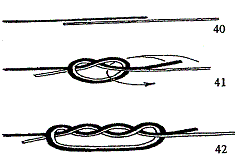 |
Square Lashing
Whenever two spars are to be crossed at any angle and lashed together for any purpose, the basic method of securing them is the Square Lashing. To make it, tie a Clove Hitch round the vertical spar, or if the spars are at an angle to one another, then just below where they cross (105). Heave it tight, twist the end and the standing part together and bring them in front of, and then over the horizontal spar, round behind the vertical one and down over the horizontal one (106). Continue to do this for three to four turns, heaving as tight as possible after each layer is made. Next, take two or three frapping turns round the lashings, between the spars, heaving as tight as you can (107:108). Finally, make a Clove Hitch round the horizontal spar (or the spar other than that on which the first Clove Hitch was made), pulling it back firmly against the lashing (109). Dispose of any spare rope by taking turns around the spar on which you finished, ending with a couple of half hitches. |







